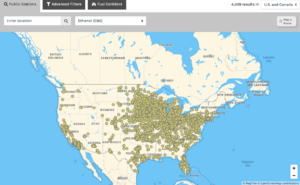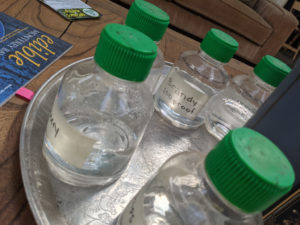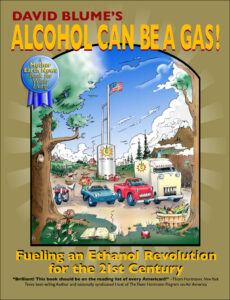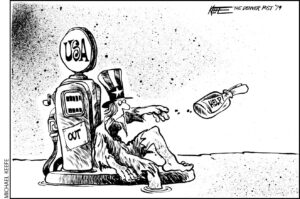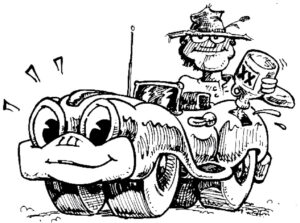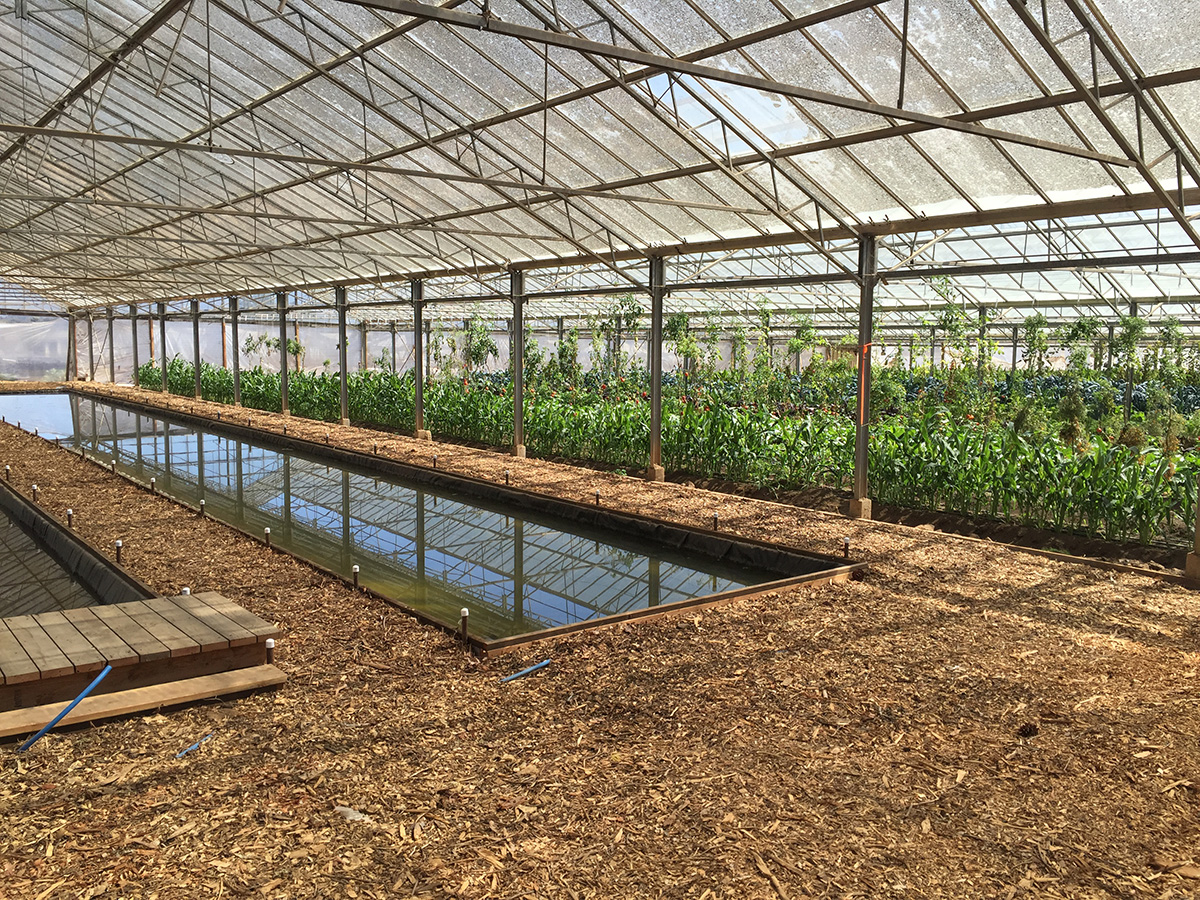
By David Blume — As a result of the current media misinformation regarding the potentials for rural revitalization and biofuel development to resolve many of our current economic and environmental concerns, I am often accosted by environmentally interested people, who ask me if I am aware that fossil fuels are beginning to run out and there is no replacement?
Typically these are sincerely interested individuals who have watched An Inconvenient Truth and are aware of Peak Oil, but they really do not understand sustainable agriculture and its ability to reverse climate change. They are being told the only thing we can do is stop driving, stop using energy, walk to our green jobs in the new localized economy, and go back to farming by hand. … Some people are actually puzzled as to why I have written a book about making it possible for American soccer moms to keep driving their massive SUVs while the rest of the world starves for basic energy. Some people think that I just don’t get it!
Believe me, I get it. I agree that we, particularly in the United States, are using and wasting a disgustingly huge quantity of energy. My fellow ecologists have a deep knowledge of natural systems, and we find ourselves every day walking through a world of horrible environmental wounds that we cannot help seeing.
Conservation and, more importantly, good design are the basic foundations on which to plan our energy future. My book, Alcohol Can Be A Gas! is not about providing unlimited clean fuels for SUVs. It’s about utilizing a localized Permaculture approach to produce sustainable food and fuel supplies while creating millions of new, non-exportable jobs to help revitalize our agricultural and manufacturing industries. It is a guide as to how we can shape energy policy with our own individual and group actions, to make sure the future we get is the one we want.
In many ways, my strident colleagues are correct when they say that the central cause of our planet’s woes can be characterized by our use of engines and fossil fuels. However, they are wrong to say, “There Is No Alternative.’” The central solution, which ripples out to every corner of the planet, is to replace those fuels with available solar-based fuels. This alternative is powerful, inexpensive, fast and effective—and will regenerate ecological as well as economic systems, if done properly. These aren’t solutions any single individual can mandate or implement by their self. These solutions require everyone’s help, blood and sweat to make happen. In fact, it’s going to take a revolution.
I am often asked how I first learned about alcohol’s ability to run vehicles? I can still remember, as clear as a bell, talking about brewing beer (which was still illegal in 1974) with Doc Sweeney, one of my ecological biology professors at San Francisco State. He was infamous for telling students outrageous tall tales with a straight face just to see their reaction, or better yet, to see if he could get away with it.
He said to me, “That beer you’re brewing could even run your car.”
His deadpan expression was daring me. “You’re lying,” I said.
And as any really excellent teacher would, he said, “Prove it.”
So I went to the library, figuring this was going to be the needle in the haystack search of all time. Much to my surprise, I found more than 30 books from the early part of the 20th century. There was a whole hidden history of alcohol as a fuel that my friends and I had never known existed. Damn that Sweeney; he hooked me good.
A few years later, during the mid-1970s gas crises, the knowledge that I gained would hold me in good stead as I started making fuel alcohol, and started working at the Mother Earth News Ecovillage research facility. Mother Earth News was a pioneering publication that was the guiding voice of the back-to-the-land movement, and its ecovillage was a seething hotbed of part-time and full-time inventors building all sorts of equipment, tools, and simple machinery that really defined appropriate technology in the U.S.
The late 1970s were an exhilarating time for those of us in the alternative energy movement. The Carter administration passed a windfall profits tax on the oil industry, when OPEC embargoed oil to the US and jacked up the price, and then plowed the money into alternative energy. They generated tax credits for alternative energy projects such as cogeneration, alcohol fuel, solar panel installation, and biomass energy equipment. In 1979, I started American Homegrown Fuel, an educational organization that would spread the word, and taught nearly 180 workshops to over 7500 people on how to produce alcohol fuel and how to convert their vehicles and equipment to use it.
Since then, I have watched in despair as our country retracted its commitment to alternative energy, beginning in the 1980s. I am angered and perplexed by the misconceptions that continue to be promoted about alcohol fuel in our popular media and I take pride in the fact that I am helping make significant advances in connecting Permaculture science with alcohol fuel production and with all of the gains we’ve made with absolutely no help from our government.
Big Agribusiness and big Oil interests have spent millions of dollars on food vs. fuel propaganda and it has become heresy to talk about alcohol fuel or any form of alternative energy being a viable solution to our energy dilemma. Debate rages around available technologies and the readiness of our economic system to absorb massive change, but primarily the concern lies with practicality and not allowing renewable fuel production to rob our food banks.
Rest assured, the United States has more than enough land to produce sustainable food and fuel leveraging good agricultural methodologies and solar energy. Based on Permaculture practices that incorporate organic farming techniques —we can shift away from industrial farming methods and to implement truly sustainable practices and alcohol fuel becomes abundantly available as a resource that can solve our energy problems.
History shows us that in order to mechanize farming—in order to remove as much labor as possible, for the benefit of corporate elites with capital—planting, cultivation, and harvesting of the land had to be simplified from husbandry to brainless machines. And so monoculture—one crop grown in one area—was born. Industrial agriculture is not a means of feeding more people, but a way to produce food with the least amount of human labor for maximum corporate profit.
The major crop used for alcohol fuel in the world today is sugarcane. Unlike corn, which is an annual crop that must be planted each year, sugarcane is a perennial, planted only once every five to ten years, and it can be harvested continually. Since Brazilian and Indian alcohol plants return most of the byproducts of alcohol production to the fields, little fertilizer is needed, and soil builds in fertility rather than loses vigor. In Brazil, sugarcane is planted on carefully laid-out contours to prevent soil loss.
Because the United States grows a lot of it, corn has become the primary crop used in making ethanol in the U.S. This is supposedly controversial, since corn is identified as a staple crop in poverty-stricken parts of the world. What most of us don’t realize is that 87% of the United States’ corn crop is fed to animals. In most years, the U.S. sends close to 20% of its corn to other countries. While it is assumed that these exports could feed most of the hungry in the world, the corn is actually sold to wealthy nations to fatten their livestock. Plus, virtually no impoverished nation will accept our corn, even when it is offered as charity, due to its being genetically modified and therefore considered unfit for human consumption.
Industrial agriculture and its components—oil-based fertilizers, pesticides, and herbicides—are harmful to the planet. A nationwide switch to organic farming is in order. But it can’t work if we maintain a monoculture-based system, with its present emphasis on corn or soy farming.
There are many crops, weeds and waste food sources that can produce far greater amounts of alcohol fuel corn. A key to the success of the Permaculture system is crop rotation, where different nutrients are used each season and nothing becomes depleted. Right now, the only common rotation in the Midwest consists of corn and soybeans. If you had four to eight different energy crops rotating, the demands on the soil would be greatly reduced and would in most cases be beneficial to rebuilding the soil.
With rotation of crops grown for energy, today’s corn farmers will begin to ask themselves, “Why not grow 800-1,000 gallon per acre crops that can still be used as food sources once the sugar and starch has been utilized for fuel production and still be able to grow a cover crop over the winter, to be turned in, providing fertilizer and organic matter to grow the next crop?” This practice is productive and profitable and gives us a cleaner environment as well as healthier soil. When farmers realize their co-op can gross $2300 per acre just on the alcohol, and can also eliminate almost all chemical input costs—it becomes difficult to consider a reason not to do it.
I spent nine years as an organic farmer 30 miles south of San Francisco. I had a little over an acre on a 35-degree slope that I terraced and a little over an acre of flat valley bottom. From those bits of land, I produced enough vegetables to provide food for as many as 450 people. The USDA says this isn’t possible. Over time, my organic matter content went from 2% to nearly 22%, the biological equivalent of converting desert sand to deep forest soil. My adobe clay soil went from one inch of topsoil to 16 inches. My loss to insect pests dropped more and more, so that by the fourth year I stopped spending any time worrying about it. I had a very nicely functioning, self-regulating, and self-maintaining ecological system that permitted me to produce huge surpluses of a great diversity of crops and make a decent living.
The key to the success of that long-term experiment was adherence to the basic tenets of Permaculture. Work with Nature, not against it. Everything is a yield; it’s up to you to realize its value and find out what to use it for. Be allergic to any extra work. Put things in the right place in relation to other things. Never fight gravity; it wins. The problem is the solution. Biology is constantly responding to stimulus, “learning” in response, and optimizing itself.
And since Permaculture should be an integral part of the alcohol fuel revolution, no easy-to-dismiss studies of annual, monocultural crops such as corn are acceptable here. Those arguments belong to another era. Groups including the American Corn Growers Association have realized the importance of Permaculture, crop diversity and the benefits of alcohol fuel production and they have teamed with me to host workshops across the country to teach better agrarian practices hopefully helping make monoculture obsolete by switching to permaculturally-based organic farming.
When I first started on this project 25 years ago, I knew it had the potential to make a substantial difference to the economics and environmental quality of the United States.
Today we are seeing very exciting indications that the book in on track to exceed my hopes. Recently ACGA presented me with their prestigious “Truth in Agricultural Journalism” award, we have Richland College in Decatur IL, selecting the book as core curriculum for its innovative Workforce Solutions two year program (repurposing recently laid-off industrial and Ag workers for a future in sustainable food and fuel development. I have been interviewed on NPR’s Science Friday with Ira Flatow and invited to speak at numerous energy fairs as well as organizational and governmental meetings in the US and across the globe.
We are changing things for the better and I am delighted to say, my book is a catalyst to the revolution I mentioned earlier. We can save our world and you and my book can help make happen.
David Blume is the Executive Director of the International Institute for Ecological Agriculture, (I.I.E.A.). He is a globally renowned Permaculture and Alcohol Fuel Expert and is author of the best selling book Alcohol Can Be A Gas (www.alcoholcanbeagas.com). Mr. Blume is the leading advocate for Alcohol Fuel and the role of the American Farmer in developing a truly sustainable energy and food policy for the post-oil era. —5/12/2009 (Published as “Alcohol Can Be a Gas” in Enviro magazine)
